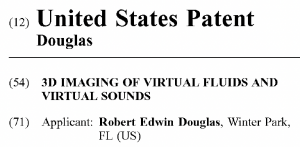A method to visually localize the origin of a sound
USA, August 16, 2023/EINPresswire.com/ — Sound localization is important in warfare. Knowing the distance and direction to the sound can help a Soldier engage the enemy more quickly. A Soldier faces a number of challenges in localization. The Soldier’s helmet can hinder auditory localization. The Soldier’s hearing can be affected from loud explosions hindering the intrinsic hearing capability. The sound could also be short lived, not providing enough time to perform localization.
Consider the first scenario in urban warfare. A shot is heard coming from a building with eight windows. The Soldier looking at the building does not see a flash, so cannot visually localize the sound.
Consider a second scenario in a rural setting. A voice is heard, but the Soldier does not see the person so cannot localize where it came from.
US Patent 10,846,911 provides technology for localizing a sound to a position coordinate and displaying a virtual object on an augmented reality display to indicate where the sound originated. If the IVAS is upgraded with the ‘911 patented technology, the Soldier can view a virtual object to indicate the location of sounds as they occur in real time or view locations of sounds at past time points. This technology is really important to the Soldier in both of these scenarios. Consider that the IVAS is upgraded to include the ‘911 patented technology.
For the first scenario, the Soldier can visually see a virtual object on the upgraded IVAS to indicate which window the sound originated from. This can help the Soldier be ready for the next time the enemy pops up from his cover to take his next shot. Additionally, given that the positions of the IVAS units are known based on US Patent 11,341,731’s pseudo-GPS system, precise sound localization can be performed using two IVAS units whose positions are known. Since the Soldier can better localize the sound, the ‘911 patented technology can improve targeting and lethality.
For the second scenario, a virtual object can be displayed on an upgraded IVAS at the location of the sound for rapid Soldier localization. Using technology in the ‘731 patent, the ‘911 patent and US 11,709,546, the sound could be localized, assigned a timepoint and GPS coordinate and other Soldiers’ upgraded IVAS units could display the novel GPS-coordinate based image enhancement to illuminate the origin of the sound. This will enable multiple Soldiers at different locations to ‘see where the sound came from’.
In addition to military applications, this could also be used for search and rescue operations since personnel would be able to visually localize sounds including the localization of sub-audible sounds, such as a trapped victim after an earthquake. Search and rescue personnel could also call up virtual objects at sites of past sounds, current sounds or predicted future sound locations via TPMI‘s patented technology.
Strategic use of virtual objects at locations of sounds is a critical improvement to IVAS. TPMI has generated a set of technological advancements, which, if integrated into the IVAS, will maximize efficiency, lethality, and survivability of the squad. The words “Visual Augmentation” in the Integrated Visual Augmentation System (IVAS) are at the heart of TPMI’s patented technology. TPMI aims to work with PEO Soldier to integrate this novel technology into the IVAS.
About the author: Dr. Robert Douglas is a West Point graduate who: fought as an Infantryman in Vietnam with US units and a Vietnam recon company; worked in a combat development agency; studied nuclear war in the Joint Chiefs of Staff; patrolled in the desert for the UN in the Middle East with Russian war planners; and developed a system to assist Air Force space exercises. After leaving the service he spent over three decades in the defense industry rising from manager to vice president working programs ranging from sensors and missiles for Air Force aircraft to rubbing shoulders with Army scientists; to Army helicopters and combat vehicles as well as rapid target acquisition night vision goggles and weapon sights.
Dr. Robert Douglas
TPMI
email us here
Visit us on social media:
Twitter
![]()
Originally published at https://www.einpresswire.com/article/650177822/a-21st-major-improvement-to-the-integrated-visual-augmentation-system




